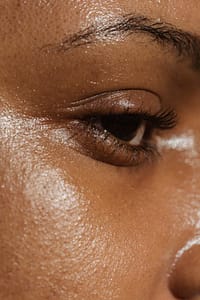Postpartum Skin Changes
After childbirth, your body undergoes a variety of changes as it adjusts back to its pre-pregnancy state. This transition doesn’t just affect your physical health but also has a significant impact on your skin. The skin changes after childbirth are often a continuation of the changes you noticed during pregnancy, but some new conditions may also emerge.
Hormonal Impact on Skin
During pregnancy, your body experiences an increase in hormones such as progesterone and estrogen, which are responsible for maintaining a healthy pregnancy and can give your skin that characteristic pregnancy glow by increasing blood flow. However, after childbirth, there’s a sudden drop in these hormone levels, which can lead to various skin conditions.
For example, you might notice that your skin becomes more prone to acne due to hormonal swings. These hormonal changes can affect the sebaceous glands, causing them to produce more oil, which can lead to breakouts. Moreover, if you have a condition like melasma, also known as the mask of pregnancy, these hormonal fluctuations could cause the dark patches to linger or become more pronounced if not managed properly. (What to Expect)
Understanding these hormonal skin changes is crucial as it helps you adapt your skincare routine postpartum to address new concerns and maintain healthy skin.
Vascular and Glandular Changes
The increase in blood volume during pregnancy by approximately 50% supports the growing fetus and gives your skin a vibrant look. Postpartum, as your body eliminates the excess blood and fluids, you might notice changes in your skin’s appearance, such as paleness or a decrease in the rosy glow you enjoyed while pregnant. (Dermatology Times)
Vascular changes, like the appearance of varicose or spider veins, are also common due to the increased estrogen levels and the pressure of the expanding uterus on the veins. Although these veins typically become less prominent or disappear in the months following childbirth, they can be a source of discomfort or self-consciousness. It’s advisable to wait 4 to 6 months post-childbirth before seeking treatment for varicose veins, as they often improve without intervention within this timeframe. (Dermatology Times)
Being aware of these vascular and glandular changes allows you to take proactive steps in managing your postpartum skin. This could include seeking advice from healthcare providers, incorporating specific skin changes and nutrition strategies, or considering a tailored skincare routine that includes proper skin changes and hydration to support your skin’s recovery.
Common Postpartum Skin Conditions
Adjusting to the myriad of changes your body experiences after childbirth includes adapting to various skin conditions that may arise. Here, we’ll discuss some of the most common skin changes after childbirth and guide managing them effectively.
Postpartum Acne
Postpartum acne can be attributed to the sebaceous glands producing excess sebum, which may clog pores and provoke breakouts. Your skincare routine should include washing your face twice daily with a gentle cleanser. It’s also crucial to resist picking or squeezing pimples, as this can lead to scarring or further skin issues. For persistent acne, you may want to consult a healthcare provider for topical treatment options. According to What to Expect, postpartum acne can take various forms, and for some women, it continues even during breastfeeding due to ongoing hormonal fluctuations.
Postpartum Dry Skin
If you find your skin feeling parched and flaky after delivery, this could be a result of the hormonal changes your body went through during pregnancy. To address postpartum dry skin, it is advisable to use a non-soap cleanser for gentle cleansing, moisturize after showering and before bedtime, limit long, hot showers, and drink plenty of water to hydrate from within. Additionally, using a humidifier can help, as well as protecting your skin from sun damage with an SPF 30+ sunscreen. These recommendations come from What to Expect and align with the broader advice on skin changes and hydration.
Postpartum Oily Skin
An increase in hormones during pregnancy can lead to stimulated oil glands, resulting in oilier skin postpartum. To manage this, opt for oil-free cosmetics and moisturizers, and ensure you’re cleaning makeup brushes regularly to prevent the build-up of oil and bacteria. If oily skin becomes a persistent issue, a dermatologist can provide potential treatments tailored to your needs.
Postpartum Hives
Postpartum hives, including conditions like PUPPP (pruritic urticarial papules and plaques of pregnancy), can emerge late in pregnancy or shortly after childbirth. Managing the discomfort of hives often involves taking antihistamines or applying topical steroids to reduce the itch. It’s important to consult with your healthcare provider to ensure these treatments are safe, especially if you are breastfeeding.
The postpartum period is a time of significant change, and adapting to new skin conditions can be challenging. Alongside these specific conditions, you might also encounter broader hormonal skin changes or have concerns about skin changes during menopause. Remember, these skin changes are common and typically temporary. However, if you find that your skin issues persist or cause you concern, don’t hesitate to reach out to a healthcare provider for personalized advice and treatment options.
Managing Postpartum Skin Changes
Navigating the landscape of postpartum skin changes can be challenging. The fluctuations in your body after childbirth can lead to a variety of skin issues. However, with the right skincare routine and lifestyle adjustments, you can manage these changes effectively.
Skincare Recommendations
To address postpartum skin changes, it is essential to adopt a skincare routine that is tailored to your current needs. If you are experiencing postpartum acne due to excess sebum production, it’s advisable to wash your face twice daily with a mild cleanser. Avoid picking or squeezing pimples to prevent further irritation or scarring. If the acne persists, consider consulting your healthcare provider for topical treatments that are safe during breastfeeding (What to Expect).
For postpartum dry skin, gentle cleansing and consistent moisturization are key. Choose a non-soap cleanser and apply a quality moisturizer after showering and before bed. Limit your showers to short durations and avoid hot water, which can strip the skin of its natural oils. Drinking plenty of water and using a humidifier can also help keep your skin hydrated from the inside out.
If oily skin is your concern, opt for oil-free cosmetics and moisturizers. Keeping your makeup brushes clean is also crucial to prevent the buildup of oils and bacteria. Should oily skin become troublesome, a dermatologist can offer solutions that may include medications or treatments to balance oil production.
For those experiencing postpartum hives, such as PUPPP, over-the-counter antihistamines or topical steroids may provide relief from itching. It’s important to consult with a healthcare provider before starting any medication, especially if you are breastfeeding.
Consultation with Healthcare Provider
While many postpartum skin conditions are temporary and can be managed at home, it’s crucial to consult with a healthcare provider if you notice persistent or severe skin changes. They can offer guidance, diagnose underlying conditions, and prescribe treatments that are safe during the postpartum period. Remember to mention any skin changes during your postnatal check-ups.
Lifestyle Changes for Skin Health
Your lifestyle plays a significant role in the health of your skin. To support skin recovery, consider the following adjustments:
- Nutrition: A balanced diet rich in vitamins, minerals, and omega-3 fatty acids can promote skin health. Explore how dietary choices impact your skin on skin changes and nutrition.
- Hydration: Adequate water intake is vital for maintaining skin hydration. Aim for at least eight glasses of water a day.
- Sleep: Prioritize sleep whenever possible to give your skin time to repair and rejuvenate.
- Stress Management: High stress levels can exacerbate skin issues. Engage in relaxation techniques or activities that you enjoy to help manage stress levels. Learn more about the connection between stress and skin on skin changes and stress.
- Sun Protection: Protect your skin from harmful UV rays by applying a broad-spectrum sunscreen with an SPF of 30 or higher every day.
Taking care of your skin after childbirth is about more than just aesthetics; it’s about nurturing your body during this significant transition. With the right approach, you can address the hormonal skin changes and embrace your new skin with confidence.
Postpartum Stretch Marks
The appearance of stretch marks after childbirth is a common concern for many women. Understanding what causes these marks and exploring effective treatment options can help in adapting to the skin changes after childbirth and improving self-confidence.
Causes and Development
Stretch marks, also known as striae, are a form of scarring that occurs when the skin expands or shrinks rapidly. This sudden change causes small tears in the collagen and elastin, the support structures of the skin. During and after pregnancy, up to 90 percent of women develop stretch marks on their abdomen, buttocks, hips, upper thighs, and breasts, often during the second or third trimesters The Bump.
These marks can vary in color, appearing as pink, purple, reddish, or brown streaks. The development of stretch marks is influenced by genetic factors, making some individuals more prone to them than others. Additionally, hormonal changes during pregnancy and those induced by birth control can contribute to the development of postpartum stretch marks The Bump.
Treatment Options
While stretch marks are permanent scars, their appearance can fade and become less noticeable with time, typically taking about a year after pregnancy to stabilize The Bump. There are various treatment options available to help improve the appearance of postpartum stretch marks:
- Topical Treatments: Creams containing hyaluronic acid and tretinoin have been shown to boost collagen production in the skin, which can improve the appearance of early stretch marks (Curology).
- Laser Therapy: Considered one of the most effective treatments, laser therapy can remove the outer layer of skin to promote new skin growth, helping stretch marks blend better with the surrounding skin (Verywell Health).
- Microneedling: This procedure involves tiny needles that create micro-injuries in the skin, stimulating repair and collagen production. It can improve skin texture and make stretch marks less noticeable (Healthline).
- Platelet-Rich Plasma (PRP): Using the patient’s own blood, PRP treatments can strengthen skin cells and improve skin color, texture, and tautness (TopDoctors).
Support Drips for Skin Recovery
In addition to the treatments mentioned, maintaining overall skin health is crucial for postpartum recovery. Ensuring adequate hydration, a balanced diet rich in vitamins and minerals, and managing stress levels can support skin health and healing. For more information on how nutrition and hydration affect your skin, visit skin changes and nutrition and skin changes and hydration.
Remember that the journey of adapting to skin changes after childbirth is unique for every individual. Consulting with a healthcare provider can help you choose the most appropriate treatment based on your specific condition and skin type. For more insights into how hormonal shifts impact your skin, explore hormonal skin changes, including those during pregnancy, menstruation, puberty, perimenopause, and menopause.


